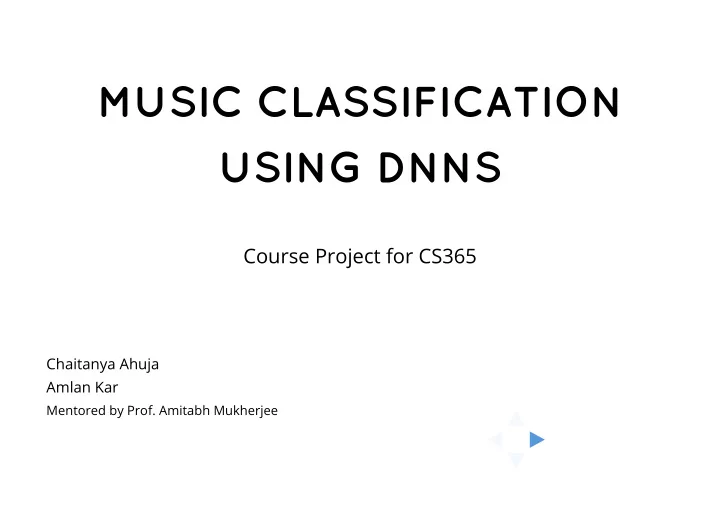

4/4/2015 ai-presentation: Slides MUSIC CLASSIFICATION USING DNNS Course Project for CS365 Chaitanya Ahuja Amlan Kar Mentored by Prof. Amitabh Mukherjee http://home.iitk.ac.in/~chahuja/cs365/project/slides/#/ 1/1
4/4/2015 ai-presentation: Slides PROBLEM STATEMENT Music Artists/Genre Model http://www.wirelesscommunication.nl/reference http://img0.gtsstatic.com/wallpapers/a465cc841 /images/voicesig.gif c36511acc5a3a3655795d40_large.jpeg http://home.iitk.ac.in/~chahuja/cs365/project/slides/#/1 1/1
4/4/2015 ai-presentation: Slides MODEL FEATURES CLASSIFIER Random Forests Handcrafted Neural Nets FFT Cepstrum MFCC HMM Neural Nets http://home.iitk.ac.in/~chahuja/cs365/project/slides/#/2 1/1
4/4/2015 ai-presentation: Slides NEURAL NETS http://home.iitk.ac.in/~chahuja/cs365/project/slides/#/3 1/1
4/4/2015 ai-presentation: Slides WHY NEURAL NET FEATURES ? Have shown to work well for random weights in the DNN structure. Any set of features can be well learnt in a DNN setting DBNN features give advantage over hand-crafted features DROPOUT The term “dropout” refers to dropping out units (hidden and visible) in a neural network. http://home.iitk.ac.in/~chahuja/cs365/project/slides/#/3/1 1/1
4/4/2015 ai-presentation: Slides HIDDEN MARKOV MODELS A state-space model of the given form Takes data points sequentially as states and trains the weights accordingly Each state generates a probability distribution over the outputs Incorporates temporal information and hence works great with speech and music *picture taken from wikipedia.org http://home.iitk.ac.in/~chahuja/cs365/project/slides/#/4 1/1
4/4/2015 ai-presentation: Slides CLASSIFICATION Random Forest (RF) classifier Why RF classifier over NN classification ? RFs do not overfit as compared to a typical DNN RFs can classify non-metric spaces http://home.iitk.ac.in/~chahuja/cs365/project/slides/#/5 1/1
4/4/2015 ai-presentation: Slides FLOWCHART http://home.iitk.ac.in/~chahuja/cs365/project/slides/#/6 1/1
4/4/2015 ai-presentation: Slides NEURAL NETWORK STRUCTURE http://home.iitk.ac.in/~chahuja/cs365/project/slides/#/7 1/1
4/4/2015 ai-presentation: Slides RESULTS Training completed for genre classification (weights and activation values obtained) Need to test on test data to check results Here cost 0 is the loss function value at the input, cost 1 is the accuracy on the validation set. The maximum validation accuracy achieved in 50 epochs was 0.62 Training with more epochs (the paper used 500) should give much better results Sigmoid function has been used as the output mask for each node http://home.iitk.ac.in/~chahuja/cs365/project/slides/#/8 1/1
4/4/2015 ai-presentation: Slides What Next? Perform unsupervised learning to Deep Belief networks to get a better feature set Compare results obtained from features of DNN, DBN and HMM http://home.iitk.ac.in/~chahuja/cs365/project/slides/#/9 1/1
4/4/2015 ai-presentation: Slides References Saxe, Andrew, et al. "On random weights and unsupervised feature learning." Proceedings of the 28th International Conference on Machine Learning (ICML-11) . 2011. Srivastava, Nitish, et al. "Dropout: A simple way to prevent neural networks from overfitting." The Journal of Machine Learning Research 15.1 (2014): 1929-1958. Gales, Mark, and Steve Young. "The application of hidden Markov models in speech recognition." Foundations and Trends in Signal Processing 1.3 (2008): 195-304. Hamel, Philippe, and Douglas Eck. "Learning Features from Music Audio with Deep Belief Networks." ISMIR . 2010. Sigtia, Siddharth, and Simon Dixon. "Improved music feature learning with deep neural networks." Acoustics, Speech and Signal Processing (ICASSP), 2014 IEEE International Conference on . IEEE, 2014. http://home.iitk.ac.in/~chahuja/cs365/project/slides/#/10 1/1
Recommend
More recommend